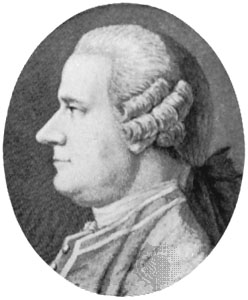<Back to Index>
- Physiologist Jan Ingenhousz, 1730
- Poet Quintus
Horatius Flaccus, 65 B.C.
- General of the Kuomintang Sun Li-jen, 1900
PAGE SPONSOR

Jan Ingenhousz or Ingen-Housz FRS (December 8, 1730 – September 7, 1799) was a Dutch physiologist, biologist and chemist. He is best known for showing that light is essential to photosynthesis and thus having discovered photosynthesis. He also discovered that plants, like animals, have cellular respiration. In his lifetime he was best known for successfully inoculating the members of the Habsburg family in Vienna against smallpox in 1768 and subsequently being the private counsellor and personal physician to the Austrian Empress Maria Theresa.
In 1779, Ingenhousz discovered that, in the presence of light, plants give off bubbles from their green parts while, in the shade, the bubbles eventually stop. He identified the gas as oxygen. He also discovered that, in the dark, plants give off carbon dioxide. He realized as well that the amount of oxygen given off in the light is more than the amount of carbon dioxide given off in the dark. This demonstrated that some of the mass of plants comes from the air, and not only the soil.
In addition to his work in the Netherlands and Vienna, Igenhousz spent time in France, England, Scotland, and Switzerland, among other places. He carried out research in electricity, heat conduction, and chemistry, and met both Benjamin Franklin and Henry Cavendish. In 1785, he described the irregular movement of coal dust on the surface of alcohol and therefore has a claim as discoverer of what came to be known as Brownian motion. Ingenhousz was elected a Fellow of the Royal Society of London in 1779.
In 1799, Ingenhousz died in, and was buried at, Calne, England. His wife died the following year.